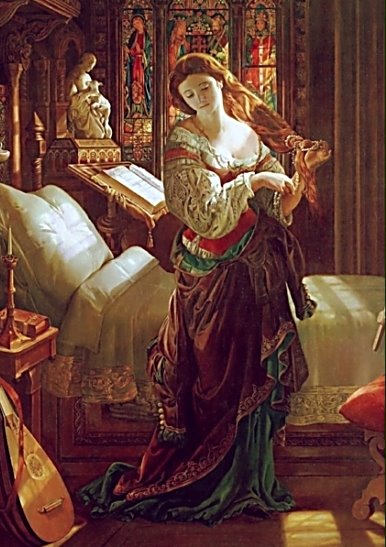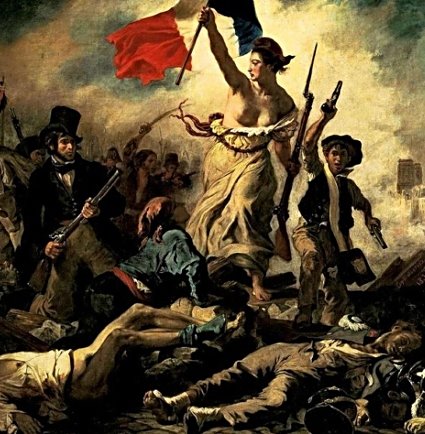The Romantic Period and The Victorian Age 1785-1901
**********************************************
"If she be small, slight-natured, miserable,
How shall men grow? but work no more alone!
Our place is much: as far as in us lies
We two will serve them both in aiding her-
Will clear away the parasitic forms
That seems to keep her up but drag her down-
Will leave her space to burgeon out of all
Within her- let her make herself her own
To give or keep, to live and learn and be
All that not harms distinctive womanhood."
(Alfred, Lord Tennyson, from
"The woman's cause is man's," Norton, Pg. 1137)
**********************************************
The Romantic Period, 1785-1830. The "Injured Woman"
Women were very oppressed by academic society during the Romantic Period in England. Women could not expect to be offered an education equal to that of men. If they were given any schooling at all, it was in the areas of study which would make them desirable to suitors. Mary Wollstonecraft thought that many of the intellectual shortcomings she saw in the women of her generation could be "attribute[d] to a false system of education" (Norton, Pg. 171). Wollstonecraft believed this lack of education available to women to be a deliberate choice by a patriarchal society in order to keep them subservient through ignorance. "Strengthen the female mind by enlarging it, and there will be an end to blind obedience... ," she writes in her essay "A Vindication on the Rights of Woman" (Norton, Pg. 176). She does not have much hope of reforming the role of women through the educational system however; "It may be fairly inferred, that, till society be differently constituted, much cannot be expected from education" (Norton, Pg. 176).
The inequalities in life at home are evident in the writings of this era as well. Barbauld's poem "Washing Day" documents the depressing reality a housewife faced when the time came to do the washing for the household, "which week, smooth sliding after week, brings on / Too soon." Women "who beneath the yoke of wedlock bend" must bear many burdens for the sake of their husbands and children, facing "all the petty miseries of life" week after week for their entire lives (Norton, Pg. 37). Wollstonecraft explains that the only choice most women have is Barbauld's "yoke of wedlock," to which women sacrifice "strength of body and mind... to libertine notions of beauty, to the desire of establishing themselves, --the only way women can rise in the world, --by marriage." (Norton, Pg. 173).
Wollstonecraft, like Barbauld, calls out to the women of her generation to assert their rights; "I wish to persuade women to endeavor to acquire strength, both of mind and body, and to convince them that the soft phrases, susceptibility of heart, delicacy of sentiment, and refinement of taste, are almost synonymous with epithets of weakness, and that those beings who are only the objects of pity... will soon become objects of contempt." (Norton, Pg. 172). She likens the current stereotypical state of women to a state of pitiful weakness which only women themselves can free themselves from. Wollstonecraft can be considered to be one of the first British feminists, blaming women themselves for accepting a second-best position in society as well as blaming men for keeping them there. It was a common belief during this era that women are born physically and mentally inferior to men. In an example of occupatio, Wollstonecraft says she will avoid making base comparisons between the faculties of men and women; but then goes on to say she "only insist[s] that men have increased that inferiority till women are almost sunk below the standard of rational creatures" (Norton, Pg. 186-7).
If the needed positive societal changes were to occur, would women be capable of transforming themselves? Unfortunately, Mary Wollstonecraft and Anna Letitia Barbauld did not live to see many improvements in the lives of women in England, or what they would make of them. Ryan Trainor spoke of Wollstonecraft during our discussion about the Victorian age; "Wollstonecraft unfortunately lived a relatively short life from 1759 until 1797 and never was able to see the Victorian Era, 1837 through 1901, or witness the marginal, if any, reforms that it constituted."

"The Nightmare" Henry Fuseli, 1781
Symbolism in Romantic Period Art
In the words of researcher Petri Liukkonen, the prolific painter Henry Fuseli was "regarded as a forerunner of the Romantic art movement and a precursor of Symbolism and Surrealism." He is most famous for his painting "The Nightmare," a vivid and haunting image of a supine woman visited by demonic creatures. A professor of painting at the Royal Academy, Fuseli had many famous pupils, including John Constable, whose work is shown at the top of this webpage. Fuseli was well-respected during his lifetime and after his death. Among his many admirers were Edgar Allen Poe, H.P. Lovecraft and Salvador Dali. Dali's painting "Invisible Sleeping Woman, Horse, Lion" is said to have been inspired by "The Nightmare."
Fuseli's painting is rife with the symbolism, sexuality, and gothic horror which is associated with the Romantic Period in England. What could the symbol of the horse, peeking out from behind the woman's bed, represent? Did Fuseli purposely create a connection between the words "mare" and "nightmare" by using the symbol of the horse in this painting? Sitting atop the sleeping woman is a demonic form, perhaps a symbol of the physiological condition of sleep paralysis, referred to in the 18th century as "the night hag." According to classmate Renee Albeln; "The creature sitting on her chest is generally accepted to be an incubus - a male demon that would come to women while they were sleeping and steal their life's energy - sometimes through sexual means" (Romanticism in Pictures Discussion).
As a whole, is this painting representative of an attack on the sexuality of the woman or Fuseli himself? Liukkonen proposes that perhaps "the picture is a revenge for an unfulfilled desire, ultimately perhaps a manifestation of a jealous passion, in which the strange lover of the woman is reduced into a monster." Fuseli painted "The Nightmare" shortly after a bitter falling-out with his lover. Could this painting be the artist's revenge or a depiction of his digust with his own desires? These types of questions are classic examples of the conflicting ideas being tackled during the Romantic Period. The Norton Anthology website states that authors explored "the realm of nightmarish terror, violence, aberrant psychological states, and sexual rapacity" alongside artists of the era. Classmate Matthew Streit comments that Fuseli "portrays the woman as helpless in this painting. At the time of the Romantic literary period, woman still had very few rights and were viewed as helpless much of the time – although women like Mary Wollstonecraft were writing about the rights women should have. I would guess that Fuseli’s artwork in the present day would likely not be well received from feminists" (Romanticism in Pictures Discussion). Interestingly enough, Fuseli and Wollstonecraft were close friends, and were rumored to have been romantically involved despite Fuseli's marriage. Liukkonen reports that "Wollstonecraft, whose portrait Fuseli painted, planned a trip with him to Paris, but after Sophia's [Fuseli's wife] intervention, the Fuseli's door was closed to her forever."
Censorship in Victorian Age Art
"Because one figure was undressed
This little drawing was suppressed.
It was unkind—
But never mind—
Perhaps it was all for the best."
("In Black and White," 1894)
After his success with Salome, Beardsley became the art editor and illustrator of The Yellow Book, a popular periodical which celebrated the avante-garde artistic tastes of the 1890's, "engaging in such burning issues as sex and the role of women." (Lambirth Pg. 12). Beardsley's influence on the role of women during the Victorian Age was immense and long-lasting, as the 1890's are and were often referred to as the "Beardsley Period."

"The Yellow Book" Cover & "Lysistrata Defending the Acropolis" Aubrey Beardsley, 1894 & 1896
Literary Terms
(Phrases in quotes are taken from the Norton Anthology's index of literary terms)
Censorship: The process of editing or "restricting" the content a piece of literature before it is published. Historical reasons for censorship are "heresy, sedition, blasphemy, libel, or obscenity." Censorship of literature that contained supposedly "obscene" content was especially important during the Victorian Age.
Character: A "figure in a literary work," used to tell a story and/or a specific viewpoint. Can be a main figure used to move the plot along or a side figure used to fill out the story.
Dialogue: In literature, any conversation or vocal interaction between characters. More obliquely, also the unspoken interchange between the author and the audience. In artwork, the unspoken interchange between the artist or work of art and the viewer. From the Greek for "conversation."
Essay: An "informal" piece of writing which muses on philosophical or social issues, "usually in prose and sometimes in verse."
Occupatio: When an author claims they will not discuss a subject "while actually discussing it." From the Latin "taking possession."
Periodical: A piece of writing which is published at certain intervals, "characteristically in the form of the essay," which became popular during the Victorian Age.
Sarcasm: An ironic, often hurtful remark or statement. From the Greek "flesh tearing."
Satire: A mode of writing in which the author pokes fun at or downright "attacks" the "ills of contemporary society" as they see it.
Symbol: "Something that stands for something else," used in literature to bring to mind another thing that is inherently related to the symbol being used.
Works Cited












I want to point out the excellent paragraph structure in this section of the paper. Each paragraph has a clear focus and each is supported with specific examples and evidence. In addition, each paragraph follows logically from the one before it.
ReplyDelete